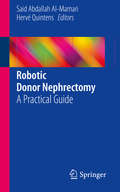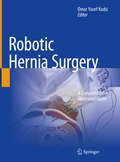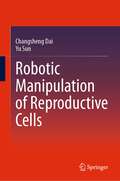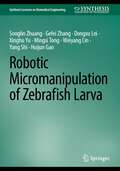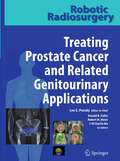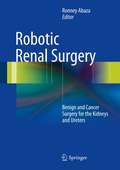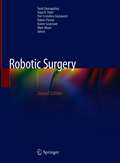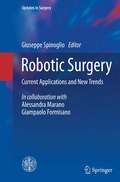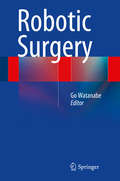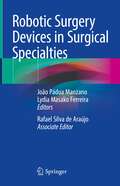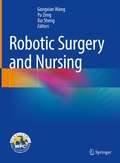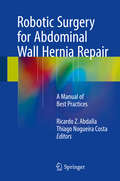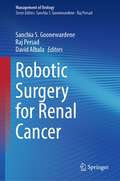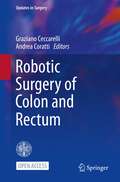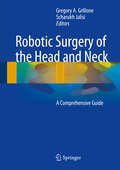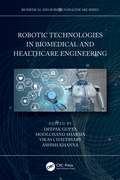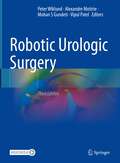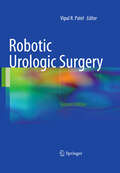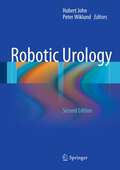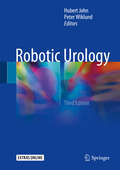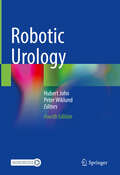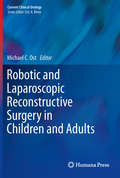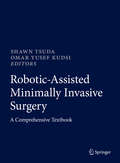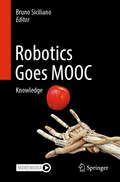- Table View
- List View
Robotic Donor Nephrectomy
by Said Abdallah Al-Mamari Hervé QuintensKidney transplantation from a living donor provides the best chance for successful renal replacement therapy. However patient's safety remains of paramount importance and complications are unacceptable. Laparoscopic donor nephrectomy (LDN) has been proven to have a lower surgical mortality and morbidity as well as a lower blood loss, a shorter hospital stay, and a better cosmetic result compared to the open procedure. This has resulted in LDN being considered the standard in many centers. Robot-Assisted Laparoscopic Donor (RALD) nephrectomy is a new trend developed in the last decade. Robotic assistance is increasingly popular worldwide, because it offers optimal operative conditions to the urological surgeon and a shorter learning curve than the standard laparoscopy.
Robotic Hernia Surgery: A Comprehensive Illustrated Guide
by Omar Yusef KudsiThis atlas demonstrates how to perform each available extraperitoneal hernia repair via a set of high-quality annotated images showing step-by-step guidance on how to perform the surgery. Robotic extraperitoneal hernia procedures are considered great teaching procedures especially with a dual teaching console. The book bridges the gap between traditional hernia and laparoscopic hernia texts by combining both approaches to create a book with a unique visual approach. Preoperative, intraoperative, and postoperative figures are integrated to highlight the importance of these step-by-step procedures, enhance skill and efficiency, and avoid surgical pitfalls. Detailed descriptive figures accompany step-by-step instructions and include specific anatomical annotations that describe the anatomy and layers of the abdominal wall during hernia procedures. Robotic Hernia Surgery provides a comprehensive, insightful and state-of-art review of this field, and serves as a valuable resource for surgeons, surgeons in training, and students with an interest in hernia and robotic hernia surgery.
Robotic Manipulation of Reproductive Cells
by Yu Sun Changsheng DaiThis is the first book to focus on robotic reproductive cell manipulation. It provides readers with the fundamental principles underpinning robotic manipulation of reproductive cells, including sperm, oocytes, and embryos, state-of-the-art technical advances in actuation, sensing and control for cell manipulation, and emerging automated systems for reproductive cell manipulation. The methods presented in the book are generic and can be translated to manipulating other types of cells, such as cancer cells and cardiomyocytes. Robotic Manipulation of Reproductive Cells will be an essential reference for graduate students and researchers working on small-scale robotic systems for cell manipulation and characterization, healthcare professionals interested in nanoscale, microscale, milli-scale robotic techniques for clinical cell surgeries and assisted reproduction, and engineers developing small-scale robotic systems for biomedical engineering, biology, and medicine.
Robotic Micromanipulation of Zebrafish Larva (Synthesis Lectures on Biomedical Engineering)
by Huijun Gao Yang Shi Songlin Zhuang Gefei Zhang Dongxu Lei Xinghu Yu Mingsi Tong Weiyang LinThis book offers readers a series of robotic methods for manipulating zebrafish larva, one of the most popular model vertebrates widely used in biomedical research and clinical applications. The authors leverage advanced control theories, image processing algorithms, and artificial intelligence to establish a robot-assisted automated or semi-automated zebrafish larva-targeted micromanipulation system for different experimental purposes. The methods presented are generic and can be translated to manipulate other types of biological objects, such as embryos or cells. Coverage includes topics that span the procedures of manipulating zebrafish larva, such as in-plane positioning, three-dimensional orientation, deformation-controllable immobilization, organ-targeted microinjection, whole-organism imaging, and high-throughput trajectory tracking of zebrafish larvae group movement.Robotic Micromanipulation of Zebrafish Larva is written in a simple, clear, and easy-to-read style. It is an ideal reference for academic researchers and biomedical operators. It is also a valuable resource for students learning robotics, control and system theories, image processing, artificial intelligence, and biomedical engineering.
Robotic Radiosurgery Treating Prostate Cancer and Related Genitourinary Applications
by Donald B. Fuller Robert M. Meier Charlie Ma Lee E. PonskyThe treatment of prostate cancer continues to be problematic owing to serious side-effects, including erectile dysfunction and urinary incontinence. Robotic radiosurgery offers a novel, rapid, non-invasive outpatient treatment option that combines robotics, advanced image-guided spatial positioning, and motion detection with submillimeter precision. This book examines all aspects of the treatment of prostate cancer with robotic radiosurgery. It explains how image-guided robotic radiosurgery overcomes the problem of patient motion during radiation therapy by continuously identifying the precise location of the prostate tumor throughout the course of treatment. Hypofractionated radiation delivery by means of robotic radiosurgery systems is also discussed in detail. The book closes by examining other emerging genitourinary applications of robotic radiosurgery. All of the authors are experts in their field who present a persuasive case for this fascinating technique.
Robotic Renal Surgery
by Ronney AbazaRobotic Renal Surgery: Benign and Cancer Surgery for the Kidneys and Ureters provides a comprehensive review of the role of and technical considerations regarding robotic surgery for conditions of the kidney and associated conditions of the upper urinary tract. In addition to serving as a reference regarding indications, preoperative and postoperative management, complications, and evidence-based outcomes, this text also serves as a practical guide for surgeons in how to perform the complete array of robotic kidney and upper tract surgery. Included are detailed descriptions of positioning, instrumentation, and surgical steps for the surgeon newly adopting robotic surgery or for those refining their techniques. All chapters are written by recognized and published experts in the various techniques, creating an authoritative text on the subject. Robotic Renal Surgery: Benign and Cancer Surgery for the Kidneys and Ureters will be of great value to urologists, robotic surgeons, fellows in urologic oncology or endourology as well as urology residents in training and surgical nurses and other surgery team members involved in these procedures.
Robotic Surgery
by Vipul R. Patel Pier Cristoforo Giulianotti Farid Gharagozloo Robert Poston Rainer Gruessner Mark MeyerThe first edition of Robotic Surgery was written only a decade after the introduction of robotic technology. It was the first comprehensive robotic surgery reference and represented the early pioneering look ahead to the future of surgery. Building upon its success, this successor edition serves as a complete multi-specialty sourcebook for robotic surgery. It seeks to explore an in-depth look into surgical robotics and remote technologies leading to the goal of achieving the benefits of traditional surgery with the least disruption to the normal functions of the human body. Written by experts in the field, chapters cover the fundamental principles of robotic surgery and provide clear instruction on their clinical application and long term results. Most notably, one chapter on “The Blueprint for the Establishment of a Successful Robotic Surgery Program: Lessons from Admiral Hymen R. Rickover and the Nuclear Navy” outlines the many valuable lessons from the transformative change which was brought about by the introduction of nuclear technology into the conventional navy with Safety as the singular goal of the change process. Robotics represents a monumental triumph of surgical technology. Undoubtedly, the safety of the patient will be the ultimate determinant of its success.The second edition of Robotic Surgery aims to erase the artificial boundaries of specialization based on regional anatomy and serves as a comprehensive multispecialty reference for all robot surgeons. It allows them to contemplate crossing boundaries which are historically defined by traditional open surgery.
Robotic Surgery
by Giuseppe SpinoglioThis book describes the current applications of the robotic system in general surgery, focusing on the technical aspects of the procedures most commonly performed by this means. It provides a comprehensive overview of the state of the art in robotic surgery and presents the most recently available evidence as documented in the literature. The opening chapters review robotic platforms, discuss the general advantages, limitations, and strategies of robotic surgery, and identify challenges and critical elements when setting up a robotic program. The full range of applications of the robotic system is then covered, encompassing thoracic, esophageal, gastric, hepatobiliopancreatic, splenic, colorectal, endocrine, and transplantation surgery. Detailed attention is also paid to innovative applications and future trends in the robotic platform, with inclusion of a special chapter on fluorescence imaging during robotic procedures. The book closes by considering aspects related to credentialing and privileging, such as mentoring, proctoring, and teaching modules for residents and fellows. Against the background of increasing acceptance of the robotic surgery system across the globe, this book will be invaluable for all general surgeons. There is no doubt that within general surgery the system will continue to flourish on account of its undoubted technical advantages, which minimize most of the intrinsic shortcomings of laparoscopy.
Robotic Surgery
by Go WatanabeThanks to the advent of leading-edge technologies, there is a new cross-sectional field of surgery: robotic surgery. Due to the rapid development of robotic surgery systems such as da Vinci, there is a great need to refresh one's knowledge every day. This book covers all surgical areas: urological surgery, digestive surgery and cardiac surgery in addition to mitral valvular disease. It also summarizes the most current topics in robotic surgery addressed by well-known experts from around the world. These specialists' expertise provides useful insights into modern educational techniques for the latest trends in surgery--knowledge that will be valuable to students, residents, and experts who are eager to learn more about advanced medical care including da Vinci as a cross-cutting surgical device, even if it lies outside their specialty field.
Robotic Surgery Devices in Surgical Specialties
by João Pádua Manzano Lydia Masako FerreiraThis engaging book is focused on surgical devices applied to several robotic systems, besides the da Vinci Robotic System, covering more than ten surgical medical specialties. The eighteen well written, objective and didactic chapters are divided into types of devices, their limitations and indications. Great exponents of surgery in Robotic System science and technology provides the readers with innovations in the field of Plastic Surgery, Orthopedics, Gynecology, Neurosurgery, Ophthalmology, Cardiac Surgery, Gastrosurgery, Head and Neck Surgery, Pediatric Surgery, Urology and Thoracic Surgery in Solo Surgery Robots. Robotic Surgery Devices in Surgical Specialties will cover a target audience that goes beyond a single specialty; medical students, residents, fellows and even experts on the subject will find this title of great value. It will certainly be the bedside book for several professionals and a source of inspiration for many to follow the field of robotic surgery.
Robotic Surgery and Nursing
by Gongxian Wang Yu Zeng Xia ShengWritten in readable format and rich with clinical cases, this book systematically introduces surgical nursing during robotic surgery. The first part introduces the history of robotic surgery, operating room management, quality control of robotic surgical nursing, management of safety, infection, and anaesthesia. The second part introduces key points of nursing during robotic surgery in urology, general surgery, gynaecology, heart, chest and otorhinolaryngology. It will be a helpful reference for practitioners those in the process of implanting or about to implant robotic surgery.
Robotic Surgery for Abdominal Wall Hernia Repair
by Ricardo Z. Abdalla Thiago Nogueira CostaThis book is a surgical manual, intended to present and discuss the use of robotic surgery for abdominal wall hernia repair. It comprises the most important surgical approaches in the field, presenting step by step procedures in a clear and didactic way. Abdominal wall hernias are very common conditions, easily identifiable in clinical practice and that usually require a surgical intervention as treatment. However, the choice for the right surgical procedure to treat those conditions may vary, provided the diversity on possible techniques, clinical presentations and complexity. Robotic surgery has emerged in recent years as an important tool to increase the number of surgical approaches for the surgeon who faces abdominal wall hernias. Video-assisted and robotic surgery may represent a consistent improvement in options available for the surgeon involved in wall hernia repair. Current robotic surgical techniques present several of the benefits of common laparoscopic surgery features (such as low invasiveness and fast recovery), and adds some other specific benefits, such as more dynamic and precise movements and a much better view of the operatory field. Robotic Surgery for Abdominal Wall Hernia Repair is intended to help surgeons to manage this disease from another point of view and to choose the best procedures in each case, pushing medical practice to another level of decisions, investigation and follow up, considering the use of new technologies in robotic surgery. It intends to be a reference manual to medical practitioners who has surgical skills in their backgrounds, but that are not familiar with the use of minimally invasive procedures for abdominal wall complex defects.
Robotic Surgery for Renal Cancer (Management of Urology)
by Raj Persad Sanchia S. Goonewardene David AlbalaThis latest book in the Management of Urology Series provides insight into how to appropriately manage patients undergoing pelvic robotic urological surgery for renal cancer. Extensive guidance is provided on how to perform a range of procedures including the retroperitoneal renal approach along with information on how to utilize the latest robots effectively. Cases are also presented on how to best manage complications associated with partial nephrectomy. Each chapter also contains learning objectives to assist the reader in extrapolating the key information covered.Robotic Surgery for Renal Cancer is an up-to-date overview of the latest techniques utilized in this field along with potential management strategies for these patients, making it a critical resource for urologists, oncologists, and specialist nurses.
Robotic Surgery of Colon and Rectum (Updates in Surgery)
by Graziano Ceccarelli Andrea CorattiThis is an open access book. Colorectal surgery is one of the most performed procedures in dedicated colorectal and general surgery units worldwide. In the last two decades, the minimally invasive laparoscopic approach has become very popular worldwide, attracting great interest among patients (lower risk of infection, less pain, and faster recovery) and demonstrating excellent oncological results. Technology is improving rapidly, offering revolutionary innovations, particularly with the advent of robotic surgery, which offers important advantages over laparoscopy for both surgeons and patients: improved ergonomics, wristed instruments, and a better vision. These advantages may be particularly useful for more complex and challenging situations (complete mesocolic excision, low rectal cancer, one-stage treatment of colorectal and liver metastases, etc.), translating into potential improved surgical and oncological results. Although several books have been published on the subject, the great interest in robotic surgery makes it mandatory, in our opinion, to have a general update in view of the latest technical innovations and the results of the most relevant and recent literature. The book is divided into chapters dealing with the different colorectal segments with their robotic surgical operations and specific technical variants. The new frontiers of benign and emergency colorectal diseases are also considered, as well as the new robotic platforms recently introduced in the healthcare market. Some of them, such as the da Vinci SP single port device, may represent a revolutionary approach for this surgery. Training and cost aspects were also considered.
Robotic Surgery of the Bladder
by Raj S. Pruthi Erik P. CastleRobotic Surgery of the Bladder is a dedicated resource to understanding and mastering the concepts and practical aspects of robotic bladder surgery. The volume provides an introduction to urologists interested in initiating robotic radical cystectomy by providing them background, concepts, steps, and tools and tricks to introduce robotic radical cystectomy into their clinical practice, all in a safe, stepwise, and organized manner. For the more experienced robotic surgeon, the text serves as a resource for more advanced applications and techniques. The volume is also accompanied by many still images and a DVD of video clips. Written by experts in the field, Robotic Surgery of the Bladder is a comprehensive resource that maintains the time-tested oncologic principles of bladder cancer surgery, while introducing the advantages that exist with robotic-assisted approaches.
Robotic Surgery of the Head and Neck
by Gregory A. Grillone Scharukh JalisiRobotic Surgery of the Head and Neck is the first comprehensive guide for otolaryngologists who wish to perform robotic head and neck surgery. Edited by leaders in the field, this book focuses on how improved access, visualization, and flexibility of the technology have greatly expanded the capabilities of the head and neck surgeon to treat diseases transorally or through small incisions in the skin. Starting with an overview of minimally invasive surgery in the head and neck, and moving to discussions of anatomic considerations for these procedures and the future applications of robotic surgery for otolaryngologists, Robotic Surgery of the Head and Neck explores the exciting progress of robotic technologies, bringing physicians closer to achieving the benefits of traditional surgery with the least amount of disruption to the patient.
Robotic Technologies in Biomedical and Healthcare Engineering (Biomedical and Robotics Healthcare)
by Deepak Gupta Ashish Khanna Moolchand Sharma Vikas ChaudharyNew prospects for biomedical and healthcare engineering are being created by the rapid development of Robotic and Artificial Intelligence techniques. Innovative technologies such as Artificial Intelligence, Deep Learning, Robotics, and IoT are currently under huge influence in today’s modern world. For instance, a micro-nano robot allows us to study the fundamental problems at a cellular scale owing to its precise positioning and manipulation ability; the medical robot paves a new way for the low-invasive and high-efficient clinical operation, and rehabilitation robotics is able to improve the rehabilitative efficacy of patients. This book aims at exhibiting the latest research achievements, findings, and ideas in the field of robotics in biomedical and healthcare engineering, primarily focusing on the walking assistive robot, telerobotic surgery, upper/lower limb rehabilitation, and radiosurgery. As a result, a wide range of robots are being developed to serve a variety of roles within the medical environment. Robots specializing in human treatment include surgical robots and rehabilitation robots. The field of assistive and therapeutic robotic devices is also expanding rapidly. These include robots that help patients rehabilitate from severe conditions like strokes, empathic robots that assist in the care of older or physically/mentally challenged individuals, and industrial robots that take on a variety of routine tasks, such as sterilizing rooms and delivering medical supplies and equipment, including medications. The objectives of the book are in terms of advancing the state-of-the-art of robotic techniques and addressing the challenging problems in biomedical and healthcare engineering. This book Lays a good foundation for the core concepts and principles of robotics in biomedical and healthcare engineering, walking the reader through the fundamental ideas with expert ease. Progresses on the topics in a step-by-step manner and reinforces theory with a full-fledged pedagogy designed to enhance students’ understanding and offer them a practical insight into the applications of it. Features chapters that introduce and cover novel ideas in healthcare engineering like Applications of Robots in Surgery, Microrobots and Nanorobots in Healthcare Practices, Intelligent Walker for Posture Monitoring, AI-Powered Robots in Biomedical and Hybrid Intelligent Systems for Medical Diagnosis, and so on. Deepak Gupta is an Assistant Professor at the Maharaja Agrasen Institute of Technology, GGSIPU, Delhi, India. Moolchand Sharma is an Assistant Professor at the Maharaja Agrasen Institute of Technology, GGSIPU, Delhi, India. Vikas Chaudhary is a Professor at the JIMS Engineering Management Technical Campus, GGSIPU, Greater Noida, India. Ashish Khanna currently works at the Maharaja Agrasen Institute of Technology, GGSIPU, Delhi, India.
Robotic Urologic Surgery
by Peter Wiklund Vipul Patel Alexandre Mottrie Mohan S GundetiThis heavily revised third edition gives an essential textbook which provides a comprehensive guide to robotic surgical techniques in urology. Extensively updated chapters cover general aspects of surgery such as aspects of operating room preparation and anesthesia. Instructions on how to use a variety of the latest techniques for procedures associated with the kidney, prostate, bladder and testicle are covered. Detailed information on how to improve outcomes, avoid potential complications and pitfalls is also provided. Instructive video clips assist the reader in being able to visualize how to enhance their methodologies further.Robotic Urologic Surgery is a detailed up-to-date resource that includes contributions from leading robotic urologic surgeons from around the world. It assists readers in refining their surgical technique and improving their patient care. Therefore, it is a critical resource for all practicing and trainee physicians involved in the care of these patients.
Robotic Urologic Surgery
by Vipul R. PatelRobotic Urologic Surgery, Second Edition is an updated and revised technical manual focusing on the various robotic approaches to robotic urologic surgical procedures. This book provides instructions on how to develop a successful robotics program, learn the various techniques, and improve outcomes. It also aids the reader with helpful hints to avoid pitfalls. Robotic Urologic Surgery, Second Edition includes up-to-date contributions from leading robotic urologic surgeons from around the world. The detailed body of data which this book provides is supported by schematic diagrams and anatomic photographs to illustrate the concept being discussed. Robotic Urologic Surgery, Second Edition is an essential guide for all urologists as a reference to establish a robotics program, refine their surgical technique, and provide information to patients.
Robotic Urology
by Peter Wiklund Hubert JohnIn this second, revised edition of Robotic Urology, leading robotic surgeons from around the world pool their knowledge to provide an updated manual that covers all the oncologic and reconstructive procedures in urologic surgery that are performed with robotic assistance. Each operation is described in detail, with careful explanation of the different surgical steps and numerous high-quality anatomic illustrations and color surgical photos. An additional feature is the inclusion of extensive references to the scientific literature. As well as offering excellent guidance on the application of robotic surgery in urology, the book will serve as an ideal reference work for all urologists and should contribute in supporting new robotic teams and further popularizing robotic surgery.
Robotic Urology
by Peter Wiklund Hubert JohnThis updated edition offers guidance on the application of robotic surgery in urology. Each technique is described in detail, with careful explanation of the different surgical stepsThe book brings together leading robotic surgeons from around the world and utilises their knowledge once again to update and provide a manual that covers all the oncologic and reconstructive procedures in urologic surgery that are performed with robotic assistance This book serves as an ideal reference work for all urologists and should contribute in supporting new robotic teams
Robotic Urology
by Peter Wiklund Hubert JohnThe first 3 editions of "Robotic Urology" have already become a gold-standard in the robotic community worldwide.This book provides a systematic and well-structured content which includes all fields of urology – general aspects on robot-assisted urologic surgery, kidney and adrenal, pelvis, bladder, prostate, reconstructive urology, and the male genital tract. The book brings together leading robotic surgeons from around the world to provide an updated text that covers all oncologic and reconstructive procedures in urologic surgery that are performed with robotic assistance.Additional questions via app: Download the Springer Nature Flashcards app for free and use exclusive additional material to test your knowledge.
Robotic and Laparoscopic Reconstructive Surgery in Children and Adults
by Michael C. OstRobotic and Laparoscopic Reconstructive Surgery in Children and Adults is a unique volume focusing on the union between adult and pediatric urologic surgical techniques. The breadth of this wonderful convergence is most clearly and consistently demonstrated when minimally invasive reconstructive techniques are utilized. This volume describes in detail the surgical steps of the major adult and pediatric reconstructive laparoscopic and robotic cases. Pediatric urologists, adult urologists, fellows, and urology residents will find this volume to be a comprehensive, yet concise, reference for most all robotic and laparoscopic procedures that may be performed within this vast discipline.
Robotic-Assisted Minimally Invasive Surgery: A Comprehensive Textbook
by Shawn Tsuda Omar Yusef KudsiMinimally invasive surgery has impacted the outcomes of surgery more than any technology since the development of sterile technique. The hard science has demonstrated that decrease in wound complications and recovery time has created the biggest gap with open approaches to surgery. The total economic benefit may be unfathomable when looked at comprehensively. Integral to the rise of minimal access and therapeutic techniques in surgery has been the growth of technological improvements over time. Beginning with insufflators, videoscopy, and energy devices, that evolution has continued into the development of tele-surgical devices that feature full articulation of instruments, high-resolution 3-D optics, and computer assisted movement. This has come with controversy – as the dominant manufacturer of robotic assisted devices, Intuitive Surgical, and their generations of da Vinci surgical platforms, holds enough market share to spur cries of monopoly and financial excess. However, with over 3000 world-wide systems in use, and over 6000 peer-reviewed research articles, the impact of robotic surgery cannot be ignored. The current state of data suggests equivalency in most procedures with regard to traditional outcome measures, equal or somewhat elevated costs, with specific areas of superiority.The first section of this textbook, Surgical Robots, covers the history, economics, training, and medico-legal aspects of robotic surgery that will be of interest to students, residents, fellows, surgical staff, and administrators or public health specialists who seek to gain a comprehensive background on robotic surgery, or justification for purchasing a robotic system for their institution. Surgeons will also find this background valuable to their practice, to give context to their procedures so they can better counsel their patients, help with advocating for robotic platform purchases, and proactively prepare themselves for medico-legal issues. The chapter on legal issues will have specific instances of robotic surgery-related lawsuits and their outcomes, a first for robotic surgery texts. The second section of this textbook, Robotic Procedures, will contain a comprehensive catalogue of procedures that have been performed robotically in general surgery, gynecology, urology, plastic surgery, cardiothoracic, and otolaryngology. Each author will cover the existing literature, preoperative planning, room and patient setup, steps of the procedure, and postoperative care. Standardized room maps and port placement will help the student, resident, fellow, surgeon or OR Staff to quickly reference these before cases. Each chapter will also cover the specific equipment needs and expected complexity of the procedures, allowing administrators to better gauge how to prepare for, or ration, use or their robotic resources. The final section, Future of Robotics, will give the entire scope of audience a look into what exciting advancements in the field are on the horizon. This textbook is a complete resource for robotic-assisted minimally invasive surgery, covering the history, current state, technical and clinical aspects, and future considerations that may be of interest to any who has a role, stake, or curiosity regarding robotic surgery.
Robotics Goes MOOC: Knowledge
by Bruno SicilianoThe robot “concept” was clearly established by those many creative historical realizations, such as those recalled above. Nonetheless, the emergence of the “physical” robot had to await the advent of its underlying technologies of mechanics, controls, computers, electronics and sensors ―in one word, mechatronics― during the course of the twentieth century. As always, new designs motivate new research and discoveries which, in turn, lead to enhanced solutions and thus to novel concepts. This virtuous circle over time produced that knowledge and understanding which gave birth to the field of Robotics, properly referred to as the science and technology of robots.To make robots and intelligent machines useful to humans it is necessary to have a broad and tight intersection between Robotics and AI. Sophisticated mathematical models are needed that enable the robot from a physical point of view, as well as intelligent algorithms capable of correlating all the information coming from the use of technologically advanced sensors with the data available from experience. It is expected that the synergy of model-based techniques with data-driven approaches will contribute to increasing the level of autonomy of robots and intelligent machines in the near future.The first book of the Robotics Goes MOOC project starts with the journey of robotics in the introductory chapter by Khatib, who has pioneered our field of robotics and has ferried it to the third millennium. Sensing is crucial for the development of intelligent and autonomous robots, as covered in Chapter 2 by Nüchter et al. Model-based control is dealt with in Chapter 3 by Kröeger et al along with motion planning, as well as in Chapter 4 by Villani and Chapter 5 by Chaumette to handle force and visual feedback, respectively, when interacting with the environment. Resorting to AI techniques is the focus of the last part of the book, namely, Chapter 6 by Peters et al on Learning, Chapter 7 byBeetz et al on knowledge representation and reasoning, and Chapter 8 by Burgard et al on graph-based SLAM.
